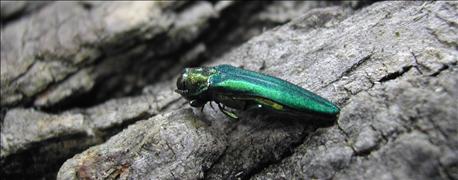
Now that emerald ash borer was confirmed in Omaha's Pulaski Park and two other nearby locations in June, it is only a matter of time for this pest to spread across the state, potentially killing millions of ash trees.
That's what Nebraska Forest Service health program leader Mark Harrell told producers and agency staff at the Nebraska Natural Resources Districts state convention in Kearney recently. Nebraska became the 27th state to confirm the presence of EAB, joining neighboring Iowa, Missouri, Kansas and Colorado.

EMERGING PEST: An adult emerald ash borer emerges from a D-shaped exit hole in the bark. EAB was first confirmed in Nebraska in June. According to NFS, it could cost almost $1 billion in ash tree cleanup and replanting over the next few decades. (Photo: Pennsylvania Department of Conservation and Natural Resources, bugwood.org)
Nebraska Department of Agriculture issued a quarantine prohibiting ash nursery stock from leaving the area. This issuance also regulates the movement of hardwood firewood and mulch, ash timber products, and green waste materials out of Douglas, Sarpy, Cass, Washington and Dodge counties to prevent the spread of EAB outside the infested area.
"Across the state, about 9% of the trees are ash," Harrell said. "That means that almost 1 in 10 trees could be impacted by EAB." If you are talking about large cities and small rural communities, the numbers are even more devastating. "About 27% of the trees in municipalities are ash," he explained.
That means that when EAB strikes a community, the cost of cleanup and replanting new trees in the wake of lost ash trees will be substantial. Harrell estimated the cost of cleaning up dead ash trees and replanting trees could be $961 million. "That's almost $1 billion as the cost of EAB," he added.
EAB is an invasive metallic green beetle that measures about a half-inch long. The larva is flattened with bell-shaped segments, resembling a small tapeworm. The tell-tale exit holes of EAB are small, D-shaped holes about an eighth-inch in diameter. Beneath the bark surface, heavily infested trees will have meandering S-shaped tunnels in the inner bark and on the surface of the wood.
This is how the pest kills the trees. It attacks by boring into the cambium, disrupting the flow of nutrients and water up the trunk and to the limbs. There are professional treatments of pesticide injections that can kill EAB. While treatments may extend the life of the tree, they can only delay the inevitable, Harrell said.
The impact of EAB will not be immediate on farms and ranches outside the already affected area, Harrell said. EAB is a hitchhiker, spreading mostly with firewood and even by riding on vehicles. "We expect it to spread first along major travel corridors like Interstate 80 and other major highways," he said. Even small communities will be at risk from this kind of method of distribution.
"It may take 10 to 20 years or more for EAB to reach more isolated places like farms and ranches," Harrell explains. "But once it is present, ash trees will be at risk."
He suggested planting a wide diversity of tree species on farms and in rural communities as a way to combat pests and diseases that can strike one variety or another. For more information on EAB in Nebraska, visit eabne.info.
About the Author(s)
You May Also Like






